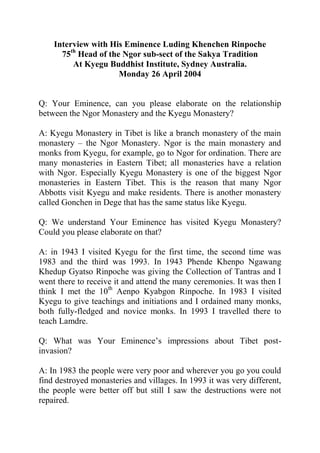
Interview with h.e. luding khenchen rinpoche
- 1. Interview with His Eminence Luding Khenchen Rinpoche 75th Head of the Ngor sub-sect of the Sakya Tradition At Kyegu Buddhist Institute, Sydney Australia. Monday 26 April 2004 Q: Your Eminence, can you please elaborate on the relationship between the Ngor Monastery and the Kyegu Monastery? A: Kyegu Monastery in Tibet is like a branch monastery of the main monastery – the Ngor Monastery. Ngor is the main monastery and monks from Kyegu, for example, go to Ngor for ordination. There are many monasteries in Eastern Tibet; all monasteries have a relation with Ngor. Especially Kyegu Monastery is one of the biggest Ngor monasteries in Eastern Tibet. This is the reason that many Ngor Abbotts visit Kyegu and make residents. There is another monastery called Gonchen in Dege that has the same status like Kyegu. Q: We understand Your Eminence has visited Kyegu Monastery? Could you please elaborate on that? A: in 1943 I visited Kyegu for the first time, the second time was 1983 and the third was 1993. In 1943 Phende Khenpo Ngawang Khedup Gyatso Rinpoche was giving the Collection of Tantras and I went there to receive it and attend the many ceremonies. It was then I think I met the 10th Aenpo Kyabgon Rinpoche. In 1983 I visited Kyegu to give teachings and initiations and I ordained many monks, both fully-fledged and novice monks. In 1993 I travelled there to teach Lamdre. Q: What was Your Eminence’s impressions about Tibet post- invasion? A: In 1983 the people were very poor and wherever you go you could find destroyed monasteries and villages. In 1993 it was very different, the people were better off but still I saw the destructions were not repaired.
- 2. Q: Your Eminence mentioned that you think you have met the 10 th Aenpo Kyabgon Rinpoche (the current, our Spiritual Director, is the 11th Aenpo Kyabgon Rinpoche). A: They are the same Aenpo Kyabgon! (laughs) A little bit different because time has changed. Same height and also very intelligent. The 10th Aenpo Kyabgon was the brother of Phende Shabdrung who resides in Paris. Q: What does Your Eminence think of the future of Buddhism in Tibet? A: I don’t know about the future but right now it is really good. I think if the situation we had in the past does not repeat again then there is a great chance of reviving Buddhism in Tibet. Q: What does Your Eminence think about the spread of Buddhism around the world? A: From my experience, Tibetan Buddhism has found its root all over the world. Q: What does Your Eminence think the biggest obstacle in the West is? A: I think the main problem is to do with the sincerity of the faith. Westerners are always looking for something new, and then they give it up and follow something else. The most important thing one should have is great faith and sincerity in practice. One should try to practice Buddhism as much as one is able to do. One should not expect quick results from practising Dharma – if you don’t get the result this generates the frustration and one gives up practice. When you plant a flower seed this time then next season you get the flower, you can’t have the result instantly.
- 3. When you try to transform yourself into the deity it is a long process and hard work and one must have great patience. Q: Your Eminence, this is your first visit to Australia. What do you think of our country? A: Australia is a really beautiful country. The people are well- mannered, well-disciplined and very caring. Q: Your Eminence has visited Tsechen Samdrup Ling [Kyegu Buddhist Institute] and kindly blessed the Centre. Would Your Eminence please elaborate on Dharma centres in Australia? A: In general Dharma centres in Australia doing really good and the students are very devoted – Tsechen Samdrup Ling is no exception. There is a great future room for growth at Tsechen Samdrup Ling. Q: Could Your Eminence please offer advice to the students? A: Generally students at Tsechen Samdrup Ling are very devoted to practice and are especially friendly to each other. My advice is to carry on and practice Dharma diligently. In general, whether it is an organisation or a family, a friendly atmosphere is very important. So if there is a friendly atmosphere among students then any activities will succeed. Q: What main practices can Your Eminence advise for students? A: It would be good to do both uncommon and common practices (uncommon means for those who have taken a major initiation). For the common practice, Tara Puja can be done daily and the Sadhana of Avalokiteshvara can be done occasionally. Ngon dro practices can also be done. For the uncommon practice, Vajrapani practice can be done but it can only be done by those who have received initiation. Q: Your Eminence what advice do you have for older students?
- 4. A: Older students should practice the Hevajra Sadhana. Once a week for a group practice and individually for daily practice. Thank you Your Eminence.